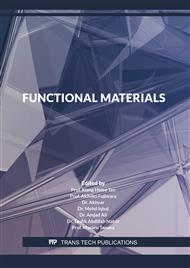[1]
Ahmad, R., Hussein, M. Z., Kadir, W. R. W. A., Sarijo, S. H., Hin, T. Y. Y., 2015, Evaluation of Controlled -Release Property and Phototoxicity Effect of Insect Pheromone Zinc-Layered Hydroxide Nanohybrid Intercalated with Hexenoic Acid, J. Agric. Food Chem., 63, 10893-10902.
DOI: 10.1021/acs.jafc.5b03102
Google Scholar
[2]
Arizaga, G. G. C., Satyanarayana, K. G., Wypych, F., 2007, Layered Hydroxide Salts: Properties and Potential Applications, Solid State Ion., 178, 1143-1162.
DOI: 10.1016/j.ssi.2007.04.016
Google Scholar
[3]
Leal, D. A., Wypych, F., Marino, C. E. B., 2020, Zinc-Layered Hydroxide Salt Intercalated with Molybdate Anions as a New Smart Nanocontainer for Active Corrosion Protection of Carbon Steel, ACS Appl. Mater. Interfaces, 12, 19823-19833.
DOI: 10.1021/acsami.0c02378
Google Scholar
[4]
Poul, L., Jouini, N., Fievet, F., 2000, Layered Hydroxide Metal Acetates (Metal = Zinc, Cobalt and Nickel): Elaboration via Hydrolysis in Polyol Medium and Comparative Study, Chem. Mater., 12, 3123-3132.
DOI: 10.1021/cm991179j
Google Scholar
[5]
Neilson, J. R., Schwenzer, B., Seshadri, R., Morse, D. E., 2009, Kinetic Control of Interlayer Cobalt Coordination in Layered Hydroxides: Co1-0.5x octCoxtet (OH)2(Cl)x(H2O)n, Inor. Chem., 48, 11017-11023.
DOI: 10.1021/ic901167u
Google Scholar
[6]
Yamanaka, S., Ando, K., Ohashi, M., 1995, New Anion Exchangable Layered Mixed Basic Salt Ni1-xZn2x(OH)2(OCOCH3)2x·nH2O, Mat. Res. Soc. Symp. Proc., 371, 131-142.
Google Scholar
[7]
Tas, M., Altin, Y., Bedeloglu, A. Y., 2019, Reduction of Graphene Oxide Thin Films using A Stepwise Thermal Annealing Assisted by L-Ascorbic Acid, Diamond & Related Materials, 92, 242-247.
DOI: 10.1016/j.diamond.2019.01.009
Google Scholar
[8]
Merino, M. J. F., Guardia, L., Paredes, I., Rodil, S. V., Fernandez, P. S., Alonso, A. M., Tascon, J. M. D., 2010, Vitamin C is An Substitute for Hydrazine in The Reduction of Graphene Oxide Suspensions, J. Phys. Chem., 114, 6426-6432.
DOI: 10.1021/jp100603h
Google Scholar
[9]
Elmagirbi, A., Sulistyarti, H., Atikah, 2012, Study of Ascorbic Acid as Iron(III) Reducing Agent for Spectrophotometric Iron Speciation, J. Pure App. Chem. Res., 1(1), 11-17.
DOI: 10.21776/ub.jpacr.2012.001.01.101
Google Scholar
[10]
An, F. Q., Li, M., Guo, X. D., Wang, H. Y., Wu, R. Y., Hu, T. P., Gao, J. F., Jiao, W. Z., 2017, Selective Adsorption of AuCl4- on Chemically Modified D301 Resin with Containing N/S Functional Polymer, Journal of Environmental Chemical Engineering, 5, 10-15.
DOI: 10.1016/j.jece.2016.11.010
Google Scholar
[11]
Ongaratto, G. C., Oro, G., Kalschne, D. L., Cursino, A. C. T., Canan, C., 2021, Cochineal carmine Adsorbed on Layered Zinc Hydroxide Salt Applied on Mortadella to Improve Color Stability, Current Research in Food Science, 4, 758-764.
DOI: 10.1016/j.crfs.2021.10.006
Google Scholar
[12]
Ikhsani, I. Y., Santosa, S. J., Rusdiarso, B., 2016, Comparative Study of Ni-Zn LHS and Mg-Al LDH Adsorbents of Navy Blue and Yellow F3G Dye, Indones. J. Chem., 16 (1), 36-44.
DOI: 10.22146/ijc.21175
Google Scholar
[13]
Santosa, S. J., Fitriani, D., Aprilita, N. H., Rusdiarso, B., 2020, Gallic and Salicylic Acid-Functionalized Mg/Al Hydrotalcite as Highly Effective Materials for Reductive Adsorption of AuCl4-, Appl. Surf. Sci., 507, 145115.
DOI: 10.1016/j.apsusc.2019.145115
Google Scholar
[14]
Musthaq, M., Tan, I. M., Ismail, L., Nadeem, M., Sagir, M., Azam, R., Hashmet, R., 2014, Influence of PZC (Point of Zero Charge) on The Static Adsorption of Anionic Surfactants on A Malaysian Sandstone, J. Dispers. Sci. Tech., 35: 3, 343-349.
DOI: 10.1080/01932691.2013.785362
Google Scholar
[15]
Tanaka, K., Kozai, N., Yamasaki, S., Ohnuki, T., Kaplan, D. I., 2019, Adsorption Mechanism of ReO4- on Ni-Zn Layered Hydroxide Salt and its Application to Removal of ReO4- as A Surrogate of TcO4-, Appl. Clay Sci., 182, 1-8.
DOI: 10.1016/j.clay.2019.105282
Google Scholar
[16]
Amnillah, M. R. T., 2019, Sintesis Garam Hidroksi Berlapis Nikel-Seng Terimobilisasi Asam Salisilat (Sal-Ni-Zn-LHS) dan Penggunaannya untuk Adsorpsi Reduktif [AuCl4]-, Tesis, Departemen Kimia FMIPA UGM, Yogyakarta.
Google Scholar
[17]
Rojas R., Ulibarri, M. A., Barriga, C., Rives, V., 2008, Intercalation of Metal-EDTA Complexes in Ni-Zn Layered Hydroxysalts and Study of their Thermal Stability, Micropor. Mesopor. Mat., 112, 262-272.
DOI: 10.1016/j.micromeso.2007.09.042
Google Scholar
[18]
Langmuir, I., 1916, The Constitution and Fundamental Properties of Solids amd Liquids, J. Am. Chem. Soc., 38, 2221-2295.
DOI: 10.1021/ja02268a002
Google Scholar
[19]
Freundlich, H. M. F., 1906, Over the Adsorption in Solution, J. Phys. Chem. A., 57, 385-470.
Google Scholar
[20]
Lagergren, S., 1898, About The Theory of So-Called Adsorption of Soluble Substances, K. Sven. Vetenskapsakad. Handl., 24, 1-39.
Google Scholar
[21]
Ho, Y. S., Wase, D. A. J., Forster, C. F., 1996, Removal of Lead Ions from Aqueous Solution using Sphagnum Moss Peat as Adsorbent, Water SA, 22, 219-224.
DOI: 10.1016/0043-1354(94)00236-z
Google Scholar
[22]
Santosa, S. J., 2014, Sorption Kinetics of Cd(II) Species on Humic Acid-Based Sorbent, Clean-Soil Air Water, 42(6), 760-766.
DOI: 10.1002/clen.201200684
Google Scholar
[23]
Kumar, K. V., Porkodi, K., Rocha, F., 2008, Langmuir-Hinshelwood Kinetics – A Theoritical Study, Catalyst Communication, 9, 82-84.
Google Scholar



